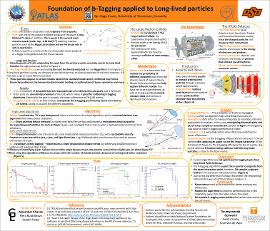| dc.contributor.advisor | Khanov, Alexander | |
| dc.contributor.author | Erwin, Gage | |
| dc.contributor.other | University of Tennessee, Knoxville | |
| dc.contributor.other | Oklahoma State University. Department of Physics | |
| dc.contributor.other | Rizatdinova, Flera | |
| dc.contributor.other | Haley, Joseph | |
| dc.contributor.other | Goswami, Soumyananda | |
| dc.contributor.other | Crosby, Jacob | |
| dc.contributor.other | Van de Wall, Evan | |
| dc.date.accessioned | 2021-07-28T04:55:54Z | |
| dc.date.available | 2021-07-28T04:55:54Z | |
| dc.date.issued | 2021-07-28 | |
| dc.identifier | oksd_USRE_2021_erwin | |
| dc.identifier.citation | Erwin, G. (2021, July 28). Foundation of b-tagging applied to long-lived particles. Poster presented at the Oklahoma State University Undergraduate Summer Research Expo, Stillwater, OK. | |
| dc.identifier.uri | https://hdl.handle.net/11244/330162 | |
| dc.description | This research, presented at the Oklahoma State University Undergraduate Summer Student Research Expo, is the work of a visiting author from the University of Tennessee, Knoxville. | |
| dc.description.abstract | The study refers to the identification of b-jets (streams of particles created through hadronization of b-quarks) observed by the ATLAS experiment at the Large Hadron Collider. It eventually aims for the detection of signals due to long-lived particles from Higgs boson decays predicted by various theories beyond the standard model. The applications of this study could potentially extrapolate the b-tagging performance used on tt-bar to ZH events, allowing for uncertainties for the ZH events to be analyzed. The tt-bar events are simulations of top-anti-top quark pairs that decay into b-quarks and are easily produced, being ideal for training algorithms. However, ZH events model the production of b quarks through the decay of Higgs-like, long-lived particles that are difficult to produce thus unsuitable to train algorithms. The methods used were to apply the same techniques of b-tagging on ZH and reweighting to account for differences in kinematic dependencies. Then tt-bar can be used to train algorithms for a better fit of the ZH events. However, the properties in these decay processes are different, and the ZH sample has decays more displaced from the beam interaction point than the tt-bar samples making the efficiencies different. To functionally make the efficiencies the same, cuts were applied to only include entries of b-hadron decay paths that are collinear with the path of the long-lived particles. In this way, the study concludes that the algorithms are not optimized for b-jets that originate far from the beam interaction point and algorithms need improvement for future studies. | |
| dc.description.sponsorship | Research Experiences for Undergraduates in Physics (National Science Foundation) | |
| dc.description.sponsorship | ATLAS Experiment | |
| dc.description.sponsorship | European Organization for Nuclear Research | |
| dc.format | application/pdf | |
| dc.language | en_US | |
| dc.publisher | Oklahoma State University | |
| dc.rights | In the Oklahoma State University Library's institutional repository this material is made available through the open access principles and the terms of agreement/consent between the author(s) and the publisher. The permission policy on the use, reproduction or distribution of the article falls under fair use for educational, scholarship, and research purposes. Contact Digital Resources and Discovery Services at lib-dls@okstate.edu or 405-744-9161 for further information. | |
| dc.title | Foundation of b-tagging applied to long-lived particles | |
| osu.filename | oksd_USRE_2021_erwin.pdf | |
| dc.description.department | High Energy Physics | |
| dc.type.genre | Poster | |
| dc.type.material | Text | |
| dc.subject.keywords | high energy physics | |
| dc.subject.keywords | b-tagging | |
| dc.subject.keywords | long-lived particles | |
| dc.subject.keywords | cern atlas experiment | |
| dc.subject.keywords | monte carlo | |
